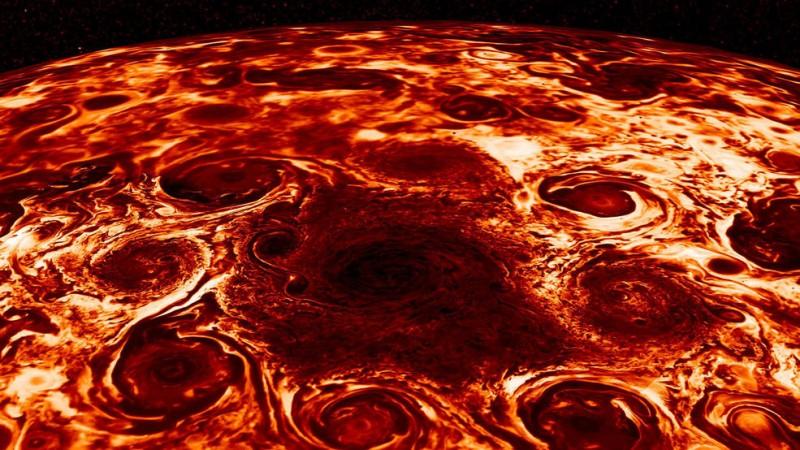NASA's Juno mission to Jupiter has just released video footage showing a closeup of the massive cyclone storms that move in clusters in the planet's north pole.
The gas giant is known to have huge storms - both cyclones and anticyclones hovering over its polar regions. Along with the video of the storms, NASA also identified and got a detailed view of "a dynamo, or engine, powering the magnetic field for any planet beyond Earth," according to a release put out by the space agency.
Data was collected by Juno's on board Jovian InfraRed Auroral Mapper (JIRAM) and a walkthrough of Jupiter's north pole was put together, showing the region in the infrared spectrum. NASA says that JIRAM can capture infrared radiation that Jupiter emits clearly, be it night or day. The instrument can penetrate Jupiter pretty deep in from the cloud tops between 50 to 70 km from where it is possible to study the gas giant's north pole. The polar region is dominated, says NASA, by a central cyclone, surrounded by 8 circumpolar cyclones. These storms are massive- between 4,000 to 4,600 km in diameter.

"Before Juno, we could only guess what Jupiter's poles would look like," said Alberto Adriani, Juno co-investigator from the Institute for Space Astrophysics and Planetology, Rome. "Now, with Juno flying over the poles at a close distance it permits the collection of infrared imagery on Jupiter's polar weather patterns and its massive cyclones in unprecedented spatial resolution."
Another aspect of these missions to study Jupiter carefully is to get to know more about the interior composition of the largest planet in the Solar System and how its interior rotates.
"Prior to Juno, we could not distinguish between extreme models of Jupiter's interior rotation, which all fitted the data collected by Earth-based observations and other deep space missions," said Tristan Guillot, a Juno co-investigator from the Université Côte d'Azur, Nice, France. "But Juno is different -- it orbits the planet from pole-to-pole and gets closer to Jupiter than any spacecraft ever before.
"Thanks to the amazing increase in accuracy brought by Juno's gravity data, we have essentially solved the issue of how Jupiter's interior rotates: The zones and belts that we see in the atmosphere rotating at different speeds extend to about 3,000 kilometers."
"At this point, hydrogen becomes conductive enough to be dragged into near-uniform rotation by the planet's powerful magnetic field," explained Guillot.
Juno has already covered nearly 200 million kilometers to complete 11 science passes from pole to pole since entering Jupiter's orbit in July 2016; the next science pass will be on May 24, says NASA.











